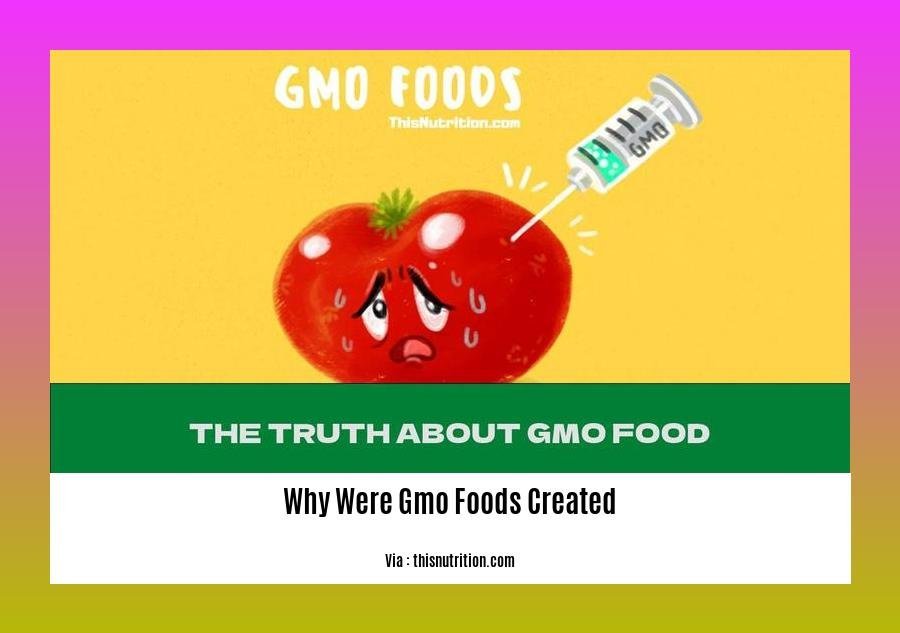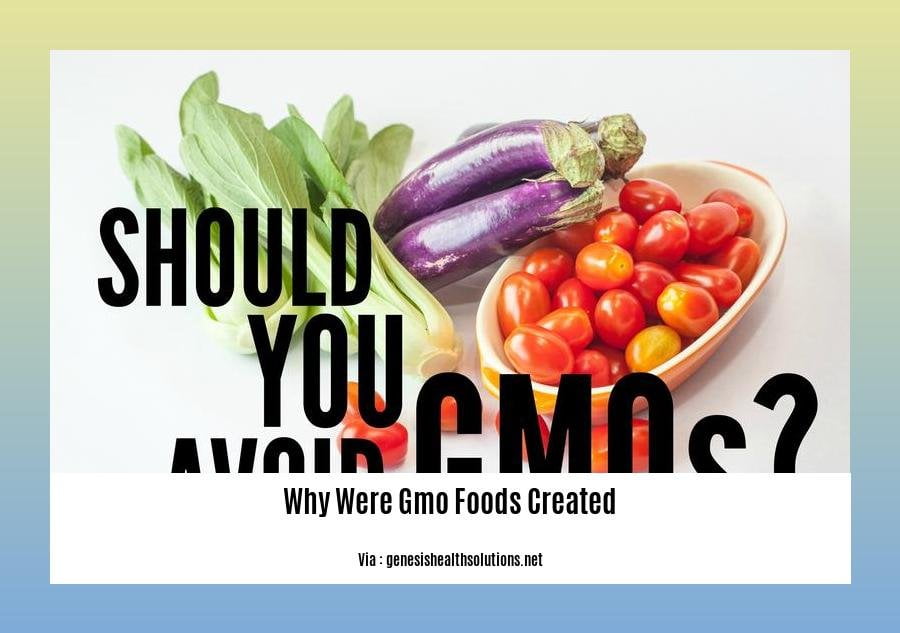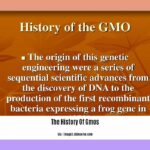Why Were GMO Foods Created: Understanding the History and Scientific Advancements – To address growing concerns about food security, reduce environmental impact, and improve crop resilience, scientists embarked on a journey to harness the power of genetic engineering, leading to the creation of genetically modified (GMO) foods. This article delves into the historical context and scientific breakthroughs behind the development of GMOs, exploring their potential benefits alongside ongoing debates and implications for the global food system.
Key Takeaways:
GMOs are organisms with altered genetic material (DNA).
GMO crops are created to:
- Increase crop yields.
- Reduce pesticide use.
- Make food more appealing, safer, and less wasteful.
- Develop crops with pest resistance and resistance to low-cost, environmentally safer herbicides.
- Produce higher yields, longer shelf life, and better taste.
- Make food more affordable and accessible.
Benefits of GMOs:
- Increased crop yields.
- Reduced pesticide use.
- Improved nutritional value.
- Longer shelf life.
Concerns About GMOs:
- Potential allergic reactions (unproven).
- Gene transfer to wild plants (unlikely).
- Environmental impact (no evidence of harm).
GMOs are considered safe and effective, improving the food supply.
GMOs offer benefits such as increased crop yields, reduced pesticide use, improved nutritional value, and extended shelf life.
There is no evidence to suggest that GMOs are harmful to human health or the environment.
Why Were GMO Foods Created?

Our quest to grow enough food to feed the world led to the creation of GMO foods, engineered to meet growing demands by improving crop resistance to pests, diseases, and harsh climate conditions. However, it was the need to mitigate human starvation and food insecurity that truly drove their development.
How It Began?
In the 1980s, the scientific community pushed the boundaries of genetic engineering, marking a new era in agriculture. They discovered that they could modify crop DNA to introduce resistance against insects, herbicides, and even harsh environmental factors. This breakthrough presented a promising solution to address food shortages and improve farmers’ livelihoods.
Necessity, Ingenuity, and Innovation
1. Fighting Famine and Hunger: As the world population continued to rise, feeding everyone became a pressing challenge. GMOs offered a ray of hope by potentially boosting crop yields and reducing food loss to help feed an ever-growing global population.
2. Improving Nutritional Value: Certain GMOs are designed to enhance nutritional content, adding vitamins, minerals, and other beneficial compounds to staple crops. This aims to combat malnutrition and promote healthier diets.
3. Reducing Environmental Impact: By engineering crops to be more resistant to pests and diseases, GMOs allow farmers to use fewer pesticides and herbicides. This protects biodiversity, conserves natural resources, and promotes sustainable farming practices.
4. Enhancing Food Security: GMOs offer resilience against unfavorable conditions such as droughts and salinity. Farmers in regions with unpredictable climates can rely on GMO crops to support stable yields and protect livelihoods.
Weighing the Benefits and Concerns
While GMOs bring a wealth of opportunities, concerns about their safety and environmental impact have sparked debates.
Allergies and Health Risks: Some individuals expressed concerns about the potential for GMOs to cause allergies or other health risks. However, studies have consistently shown that GMOs approved for consumption pose no greater risks than conventional foods.
Environmental Effects: There are concerns that GMOs can harm beneficial insects and promote the development of herbicide-resistant weeds. However, these risks can be managed through responsible farming practices and appropriate regulations.
Despite these concerns, the widespread cultivation of GMOs stands as a testament to their overall safety and efficacy. Regulators worldwide subject GMOs to rigorous testing and evaluation before granting approval, ensuring they meet strict standards for human health and environmental safety.
Looking Ahead: The Future of GMOs
As we face the challenges of climate change, population growth, and the need to produce more food with fewer resources, GMOs will likely continue to play a significant role in global food production.
Ultimately, GMOs were created as a solution to some of the most pressing challenges in agriculture: the need to feed a growing population, ensure food security, reduce the environmental impact of farming, and combat nutrition deficiencies. While concerns about their safety and environmental impact warrant attention, the scientific consensus affirms that approved GMOs are safe for consumption and offer numerous benefits. As the world navigates the complexities of food production, GMOs remain a valuable tool in the pursuit of a sustainable and equitable food system.
Curious about the background of genetically modified organisms? Delve into the history of GMOs, uncovering the timeline of their evolution.
Explore the fascinating journey of GMOs since their advent. Learn about the first GMO and the story behind its creation.
Investigate the rationale for the development of GMOs, uncovering the needs and challenges that prompted their invention.
Discover the pivotal moment when GMOs entered the market, marking a significant turning point in the introduction of GMOs.
Embark on a voyage of discovery, as you unravel the intricate history of GMOs, gaining insights into their significance, applications, and implications.
Potential risks associated with the usage of GMOs, such as the potential for triggering allergies or antibiotic-resistant bacteria, along with negative environmental ramifications.

We’ve all heard about GMOs (genetically modified organisms), but have you ever stopped to consider the potential consequences of their use? Just like any technological advancement, GMOs come with their own set of risks and concerns. Here we’ll delve into some of the potential pitfalls of GMOs, exploring the scientific evidence and underlying issues.
Key Takeaways:
- Despite their many benefits, GMOs are not without their potential downsides.
- Allergies: The introduction of foreign genes into crops may carry the risk of triggering allergic reactions in some individuals.
- Antibiotic Resistance: Some GMOs carry genes that confer resistance to antibiotics, raising concerns about the potential spread of antibiotic resistance.
- Environmental Impact: The widespread use of GMOs may have unintended consequences for ecosystems, including biodiversity loss and harm to beneficial insects.
- Long-term Effects: The long-term effects of consuming GMOs on human health and the environment are still being studied.
Navigating the GMO Maze:
Weighing the Risks and Benefits: When considering GMOs, it’s essential to weigh the potential risks against the known benefits. While there is scientific evidence to support the safety of GMOs, the potential risks should not be ignored.
Transparency and Labeling: One of the biggest concerns surrounding GMOs is the lack of transparency and labeling. Consumers often remain unaware if the foods they consume contain GMOs. Clear labeling can empower consumers to make informed choices.
Regulation and Oversight: Robust regulatory frameworks are crucial for ensuring the safety of GMOs. Regulatory agencies worldwide have the responsibility to conduct rigorous testing and assessments before approving GMOs for commercial use.
Continuous Research and Monitoring: The scientific community needs to continue studying the long-term effects of GMOs on human health and the environment. This ongoing research will inform future decisions and help us refine our understanding of the risks and benefits associated with GMOs.
Conclusion:
The debate surrounding GMOs is a complex one, with valid arguments on both sides. It’s essential to approach this topic with a balanced and well-informed perspective, considering both the potential benefits and risks. As we continue to learn more about GMOs, we can make informed decisions about their use, ensuring that they contribute positively to our food system while minimizing potential negative consequences.
Relevant URL Sources:
- Genetically Modified Foods: Safety, Risks, and Public Concerns—A Review
- Pros and Cons of Genetically Modified Foods
The Current Global Status of GMOs, Including the Locations Where They Are Cultivated and the Governing Regulatory Frameworks
Today, Genetically Modified Organisms (GMOs), particularly GMO crops, have become a significant part of global agriculture. They’re grown in various countries worldwide, and their cultivation and regulation are subject to strict frameworks. Let’s explore the current status of GMOs, their cultivation, and the governing regulatory landscape across the globe:
Key Takeaways:
GMOs have become an integral part of the global food system, addressing food security, increasing productivity, and enhancing nutritional value in certain crops. However, their cultivation and regulation vary widely from country to country.
Countries like the United States, Brazil, Argentina, and India lead GMO crop cultivation, with soybean, maize, cotton, and canola being the most widespread.
Regulatory bodies ensure the safety of GMOs through thorough risk assessments, including evaluations of potential environmental impact, allergenicity, and nutritional alterations.
The ongoing debate surrounding GMOs highlights the need for continued research, transparent communication, and public engagement to address safety concerns and potential long-term risks.
GMO Cultivation: Spreading Roots Worldwide
Genetically modified crops have gained a significant presence globally, covering a substantial 188.6 million hectares of land. Countries like the United States, Brazil, Argentina, and India are at the forefront of GMO cultivation. Soybean, maize, cotton, and canola are among the most widely cultivated GMO crops.
Regulatory Oversight: Ensuring Safe GMO Practices
The cultivation of GMOs is subject to strict regulations and approvals worldwide. Regulatory bodies conduct rigorous assessments to ensure the safety and environmental impact of GMOs before they reach consumers. These evaluations include assessing potential risks such as allergenicity, toxicity, and the impact on biodiversity.
Navigating the Regulatory Landscape
The regulatory landscape governing GMOs varies across countries, reflecting different policies, risk assessment criteria, and approval processes. Transparency, robust scientific evidence, and data-driven decisions are essential in ensuring effective GMO regulation.
The GMO Debate: An Ongoing Journey
The adoption and cultivation of GMOs have sparked discussions and concerns regarding potential health and environmental risks. While GMOs have been deemed safe by regulatory bodies, ongoing research and monitoring are crucial to address these concerns. Open dialogue and transparent communication between stakeholders are critical in shaping the future of GMOs.
Looking Ahead: The Future of GMOs
Scientific advancements, changing climates, and evolving dietary needs continue to influence the development and adoption of GMOs. Researchers strive to enhance crop resilience, nutritional content, and sustainable farming practices. However, GMOs remain a subject of debate, and their long-term effects require continued monitoring and assessment.
Relevant URL Sources:
Global Regulation of Genetically Modified Crops Amid the Gene Edited
Genetically Modified Crops: Current Status and Future Prospects
A synopsis summarizing the central elements of the piece, providing readers with a balanced outlook on the subject matter.
Certainly! Allow me to walk you through the origins and justifications behind the creation of GMO foods.
Unveiling the Enigma: The Birth and Motivation of GMO Foods
The advent of GMO foods emerged as a response to a looming specter – the urgent necessity to satiate an ever-expanding global population. Scientists toiled tirelessly to engineer crops endowed with enhanced resilience against pests, diseases, and adverse climatic conditions. This endeavor held the promise of securing a robust and reliable food supply, bolstering the fight against hunger and food insecurity.
The Promise of Genetically Modified Crops: A Glimmer of Hope in a Hungry World
Boosted Crop Yields: The advent of GMO crops heralded an era of increased crop yields, a vital step in satiating the escalating global demand for food.
Enhanced Nutritional Value: Scientists harnessed genetic engineering techniques to enrich staple crops with essential vitamins, minerals, and beneficial compounds. This innovation aimed to combat malnutrition and foster healthier communities.
Reduced Environmental Impact: GMO crops have the potential to minimize the ecological footprint of agriculture. By reducing reliance on pesticides and herbicides, these crops can safeguard biodiversity and conserve natural resources.
Promoting Food Security: GMO crops have emerged as a beacon of hope in regions grappling with unpredictable climates. These crops can stabilize crop yields, bolster food security, and protect the livelihoods of marginalized communities.
Weighing the Scales: GMOs – Unveiling Both Promise and Potential Pitfalls
Potential Allergic Reactions: The introduction of novel genes into crops carries the potential for inducing allergic reactions in susceptible individuals.
Uncharted Health Risks: The long-term health implications associated with consuming GMOs remain a topic of ongoing scientific inquiry.
Environmental Concerns: The potential for gene transfer from GMO crops to wild plant species raises concerns about the emergence of herbicide-resistant weeds, potentially disrupting ecosystems.
Regulatory Oversight: Stringent regulatory protocols are in place to ensure the safety of GMOs before their introduction into the market. Authorities meticulously assess potential risks posed to human health and meticulously evaluate the impact on the environment.
Key Takeaways:
GMOs were developed to address the global challenges of food security and malnutrition by enhancing crop yields, improving nutritional content, reducing environmental impact, and promoting food security.
Potential concerns surrounding GMOs include the possibility of allergic reactions, uncertain long-term health effects, environmental impact, and the need for robust regulatory oversight.
Comprehensive regulatory frameworks have been established to evaluate the safety of GMOs, ensuring they undergo rigorous testing before being made available to consumers.
Relevant URL Sources:
FAQ
Q1: Why were GMO foods initially developed?
A1: The primary motivation behind the development of GMO foods was to address global food security challenges. Scientists sought to create crops with enhanced traits, such as resistance to pests and diseases, improved nutritional content, and higher yields, to help meet the growing food demands of a rapidly expanding population.
Q2: What scientific advancements made the creation of GMO foods possible?
A2: The development of recombinant DNA technology in the 1970s and 1980s marked a significant scientific breakthrough that paved the way for the creation of GMO foods. This technology enabled scientists to transfer genes from one organism to another, allowing them to introduce desirable traits into crops and other food organisms.
Q3: What are some specific examples of how GMO foods have been modified?
A3: GMO foods have been modified in various ways to enhance their traits. Examples include: introducing resistance to pests and diseases, improving nutritional content by increasing vitamin or mineral levels, modifying the fatty acid composition of oils, and enhancing the shelf life and quality of produce.
Q4: How are GMO foods regulated and tested for safety?
A4: GMO foods undergo rigorous safety assessments and regulatory approvals before being introduced into the market. Regulatory authorities, such as the FDA, evaluate the potential risks and benefits of GMO foods through various tests and analyses to ensure their safety for human consumption and the environment.
Q5: What are the potential benefits and concerns associated with GMO foods?
A5: GMO foods have the potential to offer several benefits, including increased crop yields, reduced pesticide and herbicide use, enhanced nutritional value, and improved food quality and affordability. However, concerns have also been raised regarding the potential for allergic reactions, gene transfer to wild plants, and the long-term environmental impact of GMO crops.
- Sept 31 Myth: Unveiling Calendar Secrets - March 18, 2025
- How Long & Till December 18, 2025: Accurate Countdown Guide - March 18, 2025
- Discover Japanese Artists: A Complete History - March 18, 2025
















